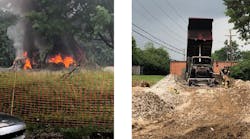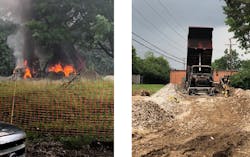The Kentucky Fatality Assessment and Control Evaluation (FACE) Program is tasked with investigating fatalities and making recommendations to ensure they do not occur again. This is one of their recent cases.
On Friday, June 22, 2018, a dump truck driver was electrocuted when he stepped off the vehicle’s running board while the raised truck bed was in contact with a high voltage power line.
At 8:00 a.m., the victim and his brother-in-law arrived at a construction site to begin work.
The 20-acre parcel of land had recently been purchased by a real estate development company with the intention of razing the area of all pre-existing structures and constructing up to 77 single-family houses. The townhouses on the land had recently been demolished, and the primary construction company subcontracted the victim to help clear the area of the debris. The victim’s job was to transport large pieces of concrete debris in his 1980 Ford L9000 2-axle dump truck to a rock crusher that was designed to reduce the rock to pieces of gravel.
After the rock was pulverized, the victim would then take the load of smaller rock to a sink hole located near a tree where he would raise the truck’s bed and dump the gravel.
At approximately 4:35 p.m., as the victim was raising the truck’s bed, he slowly backed up to dump a load of large concrete debris into the rock crusher. As the bed of the truck extended to its full raised height of 24 ft. above the ground, it made contact with overhead electrical lines carrying 7,200 volts.
This caused electricity to travel through the vehicle and catch the back tires of the truck on fire. Realizing the truck was on fire, the victim honked the horn to attract the attention of his brother-in-law who was getting a drink of water. The brother-in-law saw that the truck’s tire had begun burning, and ran towards the truck. The driver, after getting his co-worker’s attention, attempted to exit the vehicle in order to escape the flames.
The victim opened the door, stepped onto the metal running board with his hand on the exterior of the truck, stepped off with one foot, and contacted the ground.
Due to being in contact with both the ground and the electrified dump truck, the victim became grounded, completed the circuit, and was immediately electrocuted. The victim’s coworker and employees from the primary construction company were able to pull him away and doused him with a fire extinguisher to put out the flames on his body. The victim sustained charred electrical burns as well as thermal burns caused by his blue jeans catching on fire. The electrical current entered and exited his feet and hands.
The Public Service Commission investigated the scene and checked the height of the overhead power lines. They determined the power line that was contacted was found to meet or exceed the required clearance of 26 ft. from the original elevation, and the raised elevation of the site caused by debris allowed the bed of the truck to reach the high voltage wires at 24’9”.
Contributing Factors and Recommendations
Occupational injuries and fatalities are often the result of one or more contributing factors or key events in a larger sequence of events that ultimately result in the injury or fatality. NIOSH investigators identified the following unrecognized hazards as key contributing factors in this incident:
- Lack of hazard awareness
- Exiting the vehicle while in contact with high voltage lines
- Fire
- Elevated terrain
Recommendation #1
Perform a hazard assessment prior to beginning work to be aware of the hazards in the immediate work area. Prior to commencing work, employers should perform a hazard analysis in order to determine what possible dangers are present and possible resolutions. OSHA described a hazard analysis as “a technique that focuses on job tasks as a way to identify hazards before they occur. It focuses on the relationship between the worker, the task, the tools, and the work environment. Ideally, after you identify uncontrolled hazards, you will take steps to eliminate or reduce them to an acceptable risk level.”
If a hazard analysis had been performed, it is likely that the overhead power lines would have been identified as a hazard of the task due to the elevated terrain, and measures could have been taken to reduce the danger.
Recommendation #2
Require drivers to have a spotter when working around electrical lines.
In an interview with the victim’s coworker, it was determined that the dump truck the victim was driving did not have a back-up alarm, and due to the dump truck’s design, could not see what was directly behind or above the vehicle.
According to CFR 1926.601(b)(4)(ii)3, No employer shall use any motor vehicle equipment having an obstructed view to the rear unless “The vehicle is backed up only when an observer signals that it is safe to do so.”
Spotters should be a safe distance from the vehicle, have a set of predetermined signals that can be communicated to the driver, and instruct the driver to stop immediately if they lose sight of the spotter.
Had the victim used a spotter to help guide him while the dump truck was travelling in reverse, it is likely that the spotter would have observed the truck’s bed getting close to the overhead power lines, and could have instructed the driver to stop before contacting them.
Recommendation #3
Have motor vehicles working on site maintain a safe working distance from high voltage lines.
Before beginning work near high voltage wires, it should have been determined how many volts the overhead lines were carrying in order to implement plans to keep any large equipment a safe distance away.
According to CFR 1926.1408(c), “…the utility owner/operator of the power lines must provide the requested voltage information within two working days of the employer's request.” The overhead power line that the dump truck contacted was carrying 7.2 kilovolts (7,200 volts).
According to ‘Table A – Minimum Clearance Distance’ found in CFR 1926.1409, the minimum safe distance the dump truck should have been from the power lines at that voltage was 10 ft.
As a conductor of electricity gets close to a power line, especially those carrying high voltage, the electricity can ‘jump’, or arc, to the conductor. This happens when the voltage gradient (volts per meter) is sufficiently high, which can ionize gas molecules by ripping an outer electron off an atom and accelerating it. At higher voltages, electricity can arc further distances to the nearest conductor. If the voltage information had been determined, and a plan put in place to keep large equipment a safe distance from the power lines, it is likely the dump truck would never have contacted the power lines.
Recommendation #4
Stay in the vehicle and call 911.
When a vehicle contacts electrical power lines, best practice is for all passengers to remain in the vehicle and call 911. Due to the high voltage carried within power lines, electrical current can easily travel through the vehicle and into the ground below, electrifying a radius of up to 30 ft. from the vehicle. In this instance, one of the dump truck’s tires caught fire, requiring the victim to exit the vehicle before the power could be disconnected. In situations where employees must exit a charged vehicle, it is recommended to jump away from the truck as far as possible with both feet launching and then landing simultaneously.
As you move away from the vehicle, do not lift your feet to walk. Instead, keep your feet on the ground and scoot away, not allowing the heel of one foot to move past the toe of the other. Continue this method until you are 30 ft. from the vehicle. If a tingle is still felt in the body after 30 ft., continue shuffling away from the vehicle until you no longer feel this effect

